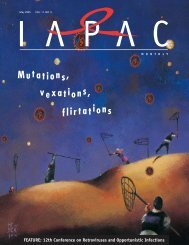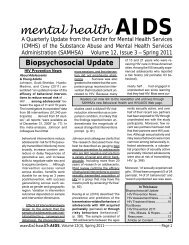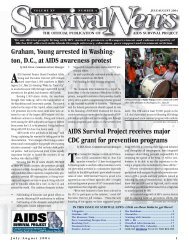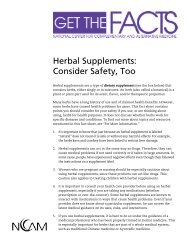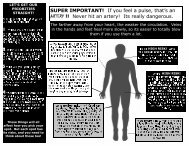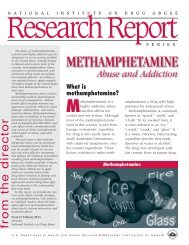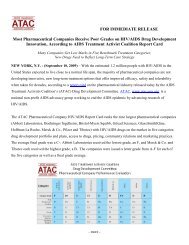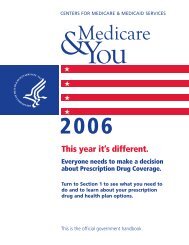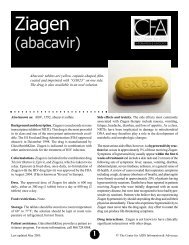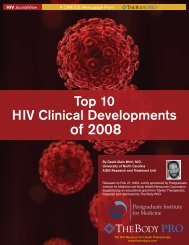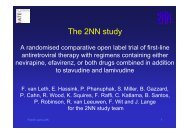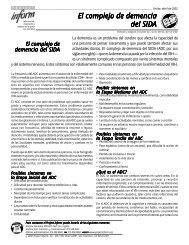Hepatitis C: New Treatments in the Pipeline - CD8 T cells - The Body
Hepatitis C: New Treatments in the Pipeline - CD8 T cells - The Body
Hepatitis C: New Treatments in the Pipeline - CD8 T cells - The Body
Create successful ePaper yourself
Turn your PDF publications into a flip-book with our unique Google optimized e-Paper software.
Doses of promis<strong>in</strong>g candidates have been modified due to safety issues. Gilead is go<strong>in</strong>g<br />
with a lower dose of GS 9190, an HCV polymerase <strong>in</strong>hibitor. Dur<strong>in</strong>g <strong>the</strong> phase III study of<br />
Albuferon (a longer-last<strong>in</strong>g formulation of <strong>in</strong>terferon be<strong>in</strong>g developed by Human Genome<br />
Sciences and Novartis), a Data Safety Monitor<strong>in</strong>g Board (DSMB) discont<strong>in</strong>ued <strong>the</strong> highest<br />
dos<strong>in</strong>g arm, due to pulmonary adverse events.<br />
A drastic shift <strong>in</strong> <strong>the</strong> HCV treatment paradigm will not occur for several years, s<strong>in</strong>ce <strong>in</strong>terferonfree<br />
regimens are years away, and ribavir<strong>in</strong> is still a necessary component of HCV treatment.<br />
Recent research has underscored its value for prevent<strong>in</strong>g viral breakthrough and lower<strong>in</strong>g<br />
relapse rates. Given emerg<strong>in</strong>g concerns with new <strong>the</strong>rapies—toxicity, drug-drug <strong>in</strong>teractions,<br />
resistance, and adherence—it is especially disappo<strong>in</strong>t<strong>in</strong>g to rema<strong>in</strong> saddled with <strong>the</strong> current<br />
standard of care.<br />
HCV treatment uptake will not <strong>in</strong>crease significantly until comb<strong>in</strong>ations of more effective, less<br />
toxic, more affordable drugs are available, particularly for people who are unlikely to respond<br />
to, or unable to tolerate, <strong>the</strong> current standard of care. Accord<strong>in</strong>g to Data Monitor, <strong>in</strong> 2006,<br />
sales of pegylated <strong>in</strong>terferon and ribavir<strong>in</strong>—<strong>the</strong> current standard of care for HCV—reached<br />
$2.5 billion <strong>in</strong> <strong>the</strong> U.S. and Europe; but sales are projected to <strong>in</strong>crease by only $1.5 billion<br />
by 2010, reflect<strong>in</strong>g <strong>the</strong> limitations of <strong>the</strong> current treatment. Better HCV drugs will be a jackpot<br />
for <strong>the</strong> pharmaceutical <strong>in</strong>dustry.<br />
PROGRESS<br />
<strong>The</strong> efficacy of HCV treatment improved with <strong>the</strong> advent of pegylated <strong>in</strong>terferon-based<br />
regimens, and <strong>the</strong>re has been additional progress s<strong>in</strong>ce <strong>the</strong>n. A steady parade of new agents<br />
is mov<strong>in</strong>g forward <strong>in</strong>to precl<strong>in</strong>ical and cl<strong>in</strong>ical development; researchers toil <strong>in</strong> state-of-<strong>the</strong>art<br />
laboratories, develop<strong>in</strong>g new drugs, attempt<strong>in</strong>g to identify correlates of spontaneous viral<br />
clearance and response to HCV treatment, and characteriz<strong>in</strong>g resistance to new HCV antiviral<br />
drugs. Activists are work<strong>in</strong>g with regulators, researchers, and <strong>in</strong>dustry to develop guidance for<br />
swift, strategic, and <strong>in</strong>clusive drug development.<br />
More effective, shorter-course HCV treatment is on <strong>the</strong> horizon. <strong>The</strong> pipel<strong>in</strong>e is full of<br />
second-generation candidates and new approaches, such as RNA <strong>in</strong>terference, to thwart<br />
HCV replication. Promis<strong>in</strong>g results have been reported from phase II studies of Vertex’s HCV<br />
protease <strong>in</strong>hibitor, telaprevir, and from Romark’s phase II study of nitazoxanide, an approved<br />
anti-protozoal agent. Data are flow<strong>in</strong>g <strong>in</strong> from phase I studies of protease and polymerase<br />
<strong>in</strong>hibitors. In <strong>the</strong> future, coformulated versions of <strong>the</strong>se oral drugs may be possible.<br />
9



